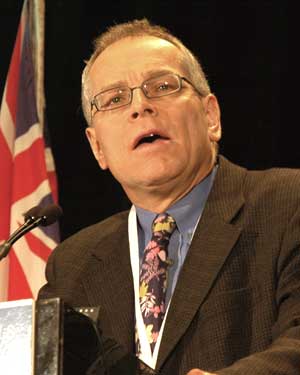Footings In Place









December 13, 2006
BY Nicholas Zeman
When President George W. Bush stumped for cellulosic ethanol in his 2006 State of the Union address, it didn't only catapult the concept of producing ethanol from biomass into the mainstream, it supercharged the race to commercialize the process itself. "The president said ‘switchgrass' and … all of a sudden, my father [understands] what I do—it's just amazing," says Steve Kelley, department head of wood and paper sciences at North Carolina State University. The U.S. DOE, the USDA and groups like the National Science Foundation all realized cellulose was "a big deal"—and definitely on the way—long before the president touted wood-chips-to-ethanol. However, government funding wasn't necessarily in sync with government enthusiasm. "There's recognition and there's money, and those don't always follow hand-in-hand," Kelley says.
It also didn't hurt that the president's address to the nation came just two days after the journal Science published an article written by University of California, Berkeley scientists that said the "large-scale use" of ethanol would almost certainly require cellulosic technologies. These developments, in part, abetted the proliferation of research and development efforts backed by some serious cash in 2006. In May, Canada's Iogen Corp. got financial backing to pursue its cellulosic ethanol technology efforts in the form of $30 million from Goldman Sachs & Co. of New York. The Canadian company first started producing ethanol from wheat straw and barley straw on a demonstration scale in 2004 at its headquarters in Ottawa, Ontario. In June, Iogen announced that it would build its first commercial-scale cellulosic ethanol plant in Idaho, a decision largely influenced by cellulosic ethanol incentives housed in the Energy Policy Act of 2005 (EPAct). Specifically, loan provision guarantees in the legislation make it easier for cellulose-based research projects and would-be producers to secure capital.
The possibilities for developing innovative technology has attracted some heavyweight investors from outside the ethanol industry. Following Bill Gates' injection of cash into California start-up Pacific Ethanol Inc., billionaire Vinod Khosla entered the fray. He pumped money into companies like Celunol Corp., which has a pilot-scale cellulosic ethanol plant—and an ambitious plan.
Pairing Strengths
The competition is serious among the various international players now simultaneously developing process technologies to make cellulose-to-ethanol commercially viable, says David Bransby, a scientist at Auburn University, who has outlined the four principal systems for biomass-to-fuel refining.
As Kelley explains, it's not that scientists—or producers, for that matter—don't know how to turn non-grain biomass into alcohol. They do. It's just that making the process viable on a real-world, commercial-scale basis has proven to be a whole other ballgame.
Celunol, formerly BC International, has focused its attention on enzyme hydrolysis and fermentation at its pilot plant in Jennings, La. The company uses a biochemical approach to convert cellulose to ethanol. Others like Kergy Inc. of Broomfield, Colo., use a thermochemical approach, "but it's too early to say which technology will win, or how many will win," Khosla told EPM in October. "This is a large market, so I suspect a few different approaches will find success."
Bioengineering Resources Inc. of Fayetteville, Ark., is commercializing a gasification and fermentation process that uses bacteria to convert syngas to ethanol. Furthermore, gasification and catalytic conversion are being developed by Canada-based Syntec Biofuel Inc.
Competition also exists among companies experimenting with the same processes. For example, the acid hydrolysis and fermentation process typically yields about 60 gallons of ethanol per dry ton of biomass. However, Arkenol Inc. says its process will almost double that yield, Bransby says.
The race to commercialize cellulosic ethanol production has produced some interesting relationships involving young, emerging companies, old-school industry giants, government agencies and quasi-government research entities. In October, Chevron Technology Ventures and NREL penned a five-year agreement to research and develop the next generation of process technologies that will convert cellulosic biomass, such as forestry and farm wastes, into fuel. This announcement was quickly followed by news that Sioux Falls, S.D.-based Broin Companies and DuPont were partnering to research cellulosic ethanol.
Since 2003, DuPont and the DOE have worked jointly on technology to convert corn stover into ethanol. Reportedly, this partnership involves DuPont licensing the resultant technology to Broin, which in turn will develop a commercial-scale biorefinery. Broin recently unveiled its plan for Project LIBERTY (Launch of an Integrated Biorefinery with Eco-Sustainable and Renewable Technologies in the year 2009). The company will spend $200 million to convert its Voyager Ethanol plant in Emmetsburg, Iowa, from a 50 MMgy conventional ethanol plant into a 125 MMgy commercial-scale biorefinery. The facility will produce ethanol from corn and corn stover using advanced corn fractionation and lignocellulosic conversion processes.
Collocating a cellulosic ethanol refinery at the site of an existing corn ethanol plant is a good way to edge toward commercialization, Javier Salgado, CEO of the Abengoa Bioenergy Business Group, told EPM in February. Salgado said he believes the integration of starch and cellulosic technologies into hybrid biomass plants is the strongest solution to the economic challenges preventing the proliferation of ethanol from biomass. "Our hybrid plant concept lowers the technology risk and the capital requirements—essential for an economically viable project—to secure financing in the marketplace," he said.
Feedstocks and Logistics
While capital and innovation are necessities to compete in the race to commercially apply cellulosic ethanol research, so is the development of a feedstock pool to support it. In July, the DOE published a 200-page scientific "roadmap" that identified the research required to overcome challenges to the large-scale production of cellulosic ethanol. The report, titled "Breaking the Biological Barriers to Cellulosic Ethanol: A Joint Research Agenda," focused on the biomass crops that could be used to sustain the biofuels industry.
Several analysts have concurred that switchgrass is indeed a top contender as a cellulosic ethanol feedstock, not only because of its process components, but also because it's an eligible Conservation Reserve Program crop. Plus, switchgrass is physically similar to wheat, a crop farmers have experience harvesting and storing. There are a wide variety of plants being studied for potential energy crops. However, due to environmental concerns, economic factors and logistics, the frontrunners are switchgrass and other prairie grasses indigenous to North American soil, Bransby says. These can be introduced using seed, and won't draw protest from environmental advocates.
The future expansion of the U.S. ethanol industry through the introduction of biomass feedstocks will allow the production to truly proliferate outside of the Corn Belt, says Daniel de la Torre Ugarte, professor at the University of Tennessee. However, inexperience with these "new" materials and waste streams, in terms of harvesting and processing, remain obstacles to be overcome.
Fortunately, there are companies willing to invest in the steps necessary to remove those barriers. For example, Colusa Biomass Energy Corp. announced in late August that it had selected a site for a 10 MMgy rice-straw-to-ethanol refinery. The 15-acre site is part of an existing industrial park in Colusa, Calif., a prime rice-producing area of the Sacramento Valley.
Today, many experts believe there are more economic barriers than scientific barriers to making rice straw a legitimate and successful cellulosic ethanol production feedstock. What is perhaps today's most significant challenge—one that certainly rivals conversion hurdles, experts say—is collection and storage of the straw. "Farmers don't want to drive more than 50 or 100 miles … and every mile they go adds to the [lifecycle] energy cost," says William Orts of the USDA's Agricultural Research Service western regional office. "That is one component that doesn't track well if oil prices are going up. Then the price to move the straw is going up, as well."
Starting from scratch is always difficult. That's certainly true in the cellulosic ethanol game, but there are some existing industries that offer potential starting points. The pulp and paper industry, for example, is a decaying industry that has left dozens of facilities across the United States mothballed—or close to it. Now, experts say these plants are ideal candidates to be retrofitted and transformed into cellulosic biorefineries. In addition, scientists recently sequenced the genome for the poplar tree. This advancement could lead to genetic modifications that allow this species to become an ideal dedicated energy crop for ethanol production. "The theory is to optimize cell wall chemistry to perfect the ratio of lignin-to-cellulose, as well as yield per unit area of land," says Gerald Tuskan, lead scientist of the Feedstock Development Program at Oak Ridge National Laboratory in Oak Ridge, Tenn. "Increased yield does more to decrease the cost than anything we can do to manipulate the plant material." Cutting-edge genetic technology combined with the revitalization of an older industrial infrastructure, like the paper and pulp industry, could provide the appropriate impetus to significantly expand the ethanol industry.
Nicholas Zeman is an Ethanol Producer Magazine staff writer. Reach him at nzeman@bbibiofuels.com or (701) 746-8385.
It also didn't hurt that the president's address to the nation came just two days after the journal Science published an article written by University of California, Berkeley scientists that said the "large-scale use" of ethanol would almost certainly require cellulosic technologies. These developments, in part, abetted the proliferation of research and development efforts backed by some serious cash in 2006. In May, Canada's Iogen Corp. got financial backing to pursue its cellulosic ethanol technology efforts in the form of $30 million from Goldman Sachs & Co. of New York. The Canadian company first started producing ethanol from wheat straw and barley straw on a demonstration scale in 2004 at its headquarters in Ottawa, Ontario. In June, Iogen announced that it would build its first commercial-scale cellulosic ethanol plant in Idaho, a decision largely influenced by cellulosic ethanol incentives housed in the Energy Policy Act of 2005 (EPAct). Specifically, loan provision guarantees in the legislation make it easier for cellulose-based research projects and would-be producers to secure capital.
The possibilities for developing innovative technology has attracted some heavyweight investors from outside the ethanol industry. Following Bill Gates' injection of cash into California start-up Pacific Ethanol Inc., billionaire Vinod Khosla entered the fray. He pumped money into companies like Celunol Corp., which has a pilot-scale cellulosic ethanol plant—and an ambitious plan.
Pairing Strengths
The competition is serious among the various international players now simultaneously developing process technologies to make cellulose-to-ethanol commercially viable, says David Bransby, a scientist at Auburn University, who has outlined the four principal systems for biomass-to-fuel refining.
As Kelley explains, it's not that scientists—or producers, for that matter—don't know how to turn non-grain biomass into alcohol. They do. It's just that making the process viable on a real-world, commercial-scale basis has proven to be a whole other ballgame.
Celunol, formerly BC International, has focused its attention on enzyme hydrolysis and fermentation at its pilot plant in Jennings, La. The company uses a biochemical approach to convert cellulose to ethanol. Others like Kergy Inc. of Broomfield, Colo., use a thermochemical approach, "but it's too early to say which technology will win, or how many will win," Khosla told EPM in October. "This is a large market, so I suspect a few different approaches will find success."
Bioengineering Resources Inc. of Fayetteville, Ark., is commercializing a gasification and fermentation process that uses bacteria to convert syngas to ethanol. Furthermore, gasification and catalytic conversion are being developed by Canada-based Syntec Biofuel Inc.
Competition also exists among companies experimenting with the same processes. For example, the acid hydrolysis and fermentation process typically yields about 60 gallons of ethanol per dry ton of biomass. However, Arkenol Inc. says its process will almost double that yield, Bransby says.
The race to commercialize cellulosic ethanol production has produced some interesting relationships involving young, emerging companies, old-school industry giants, government agencies and quasi-government research entities. In October, Chevron Technology Ventures and NREL penned a five-year agreement to research and develop the next generation of process technologies that will convert cellulosic biomass, such as forestry and farm wastes, into fuel. This announcement was quickly followed by news that Sioux Falls, S.D.-based Broin Companies and DuPont were partnering to research cellulosic ethanol.
Since 2003, DuPont and the DOE have worked jointly on technology to convert corn stover into ethanol. Reportedly, this partnership involves DuPont licensing the resultant technology to Broin, which in turn will develop a commercial-scale biorefinery. Broin recently unveiled its plan for Project LIBERTY (Launch of an Integrated Biorefinery with Eco-Sustainable and Renewable Technologies in the year 2009). The company will spend $200 million to convert its Voyager Ethanol plant in Emmetsburg, Iowa, from a 50 MMgy conventional ethanol plant into a 125 MMgy commercial-scale biorefinery. The facility will produce ethanol from corn and corn stover using advanced corn fractionation and lignocellulosic conversion processes.
Collocating a cellulosic ethanol refinery at the site of an existing corn ethanol plant is a good way to edge toward commercialization, Javier Salgado, CEO of the Abengoa Bioenergy Business Group, told EPM in February. Salgado said he believes the integration of starch and cellulosic technologies into hybrid biomass plants is the strongest solution to the economic challenges preventing the proliferation of ethanol from biomass. "Our hybrid plant concept lowers the technology risk and the capital requirements—essential for an economically viable project—to secure financing in the marketplace," he said.
Feedstocks and Logistics
While capital and innovation are necessities to compete in the race to commercially apply cellulosic ethanol research, so is the development of a feedstock pool to support it. In July, the DOE published a 200-page scientific "roadmap" that identified the research required to overcome challenges to the large-scale production of cellulosic ethanol. The report, titled "Breaking the Biological Barriers to Cellulosic Ethanol: A Joint Research Agenda," focused on the biomass crops that could be used to sustain the biofuels industry.
Several analysts have concurred that switchgrass is indeed a top contender as a cellulosic ethanol feedstock, not only because of its process components, but also because it's an eligible Conservation Reserve Program crop. Plus, switchgrass is physically similar to wheat, a crop farmers have experience harvesting and storing. There are a wide variety of plants being studied for potential energy crops. However, due to environmental concerns, economic factors and logistics, the frontrunners are switchgrass and other prairie grasses indigenous to North American soil, Bransby says. These can be introduced using seed, and won't draw protest from environmental advocates.
The future expansion of the U.S. ethanol industry through the introduction of biomass feedstocks will allow the production to truly proliferate outside of the Corn Belt, says Daniel de la Torre Ugarte, professor at the University of Tennessee. However, inexperience with these "new" materials and waste streams, in terms of harvesting and processing, remain obstacles to be overcome.
Fortunately, there are companies willing to invest in the steps necessary to remove those barriers. For example, Colusa Biomass Energy Corp. announced in late August that it had selected a site for a 10 MMgy rice-straw-to-ethanol refinery. The 15-acre site is part of an existing industrial park in Colusa, Calif., a prime rice-producing area of the Sacramento Valley.
Today, many experts believe there are more economic barriers than scientific barriers to making rice straw a legitimate and successful cellulosic ethanol production feedstock. What is perhaps today's most significant challenge—one that certainly rivals conversion hurdles, experts say—is collection and storage of the straw. "Farmers don't want to drive more than 50 or 100 miles … and every mile they go adds to the [lifecycle] energy cost," says William Orts of the USDA's Agricultural Research Service western regional office. "That is one component that doesn't track well if oil prices are going up. Then the price to move the straw is going up, as well."
Starting from scratch is always difficult. That's certainly true in the cellulosic ethanol game, but there are some existing industries that offer potential starting points. The pulp and paper industry, for example, is a decaying industry that has left dozens of facilities across the United States mothballed—or close to it. Now, experts say these plants are ideal candidates to be retrofitted and transformed into cellulosic biorefineries. In addition, scientists recently sequenced the genome for the poplar tree. This advancement could lead to genetic modifications that allow this species to become an ideal dedicated energy crop for ethanol production. "The theory is to optimize cell wall chemistry to perfect the ratio of lignin-to-cellulose, as well as yield per unit area of land," says Gerald Tuskan, lead scientist of the Feedstock Development Program at Oak Ridge National Laboratory in Oak Ridge, Tenn. "Increased yield does more to decrease the cost than anything we can do to manipulate the plant material." Cutting-edge genetic technology combined with the revitalization of an older industrial infrastructure, like the paper and pulp industry, could provide the appropriate impetus to significantly expand the ethanol industry.
Nicholas Zeman is an Ethanol Producer Magazine staff writer. Reach him at nzeman@bbibiofuels.com or (701) 746-8385.
Advertisement
Advertisement
Advertisement
Advertisement
Upcoming Events





